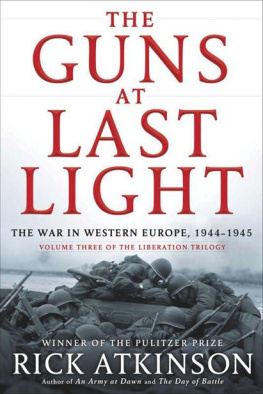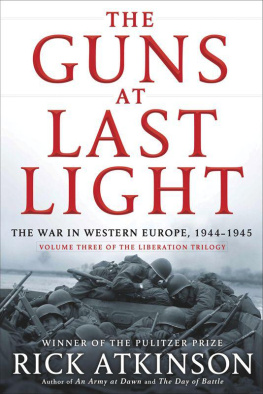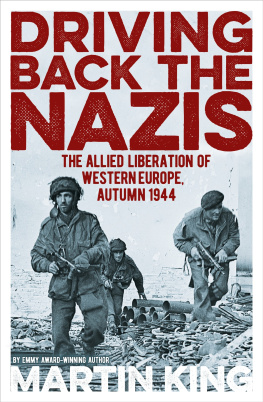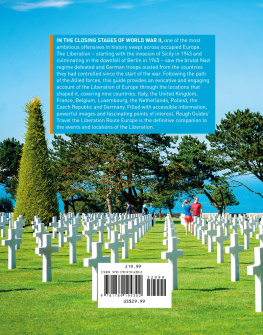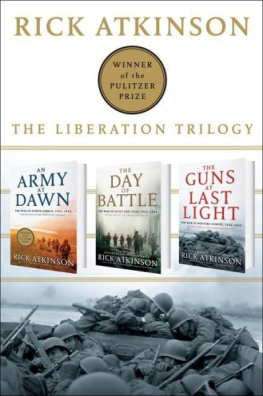Rick Atkinson - The liberation trilogy. 3, The guns at last light: the war in Western Europe, 1944-1945
Here you can read online Rick Atkinson - The liberation trilogy. 3, The guns at last light: the war in Western Europe, 1944-1945 full text of the book (entire story) in english for free. Download pdf and epub, get meaning, cover and reviews about this ebook. City: New York, year: 2013, publisher: Henry Holt and Co., genre: Science. Description of the work, (preface) as well as reviews are available. Best literature library LitArk.com created for fans of good reading and offers a wide selection of genres:
Romance novel
Science fiction
Adventure
Detective
Science
History
Home and family
Prose
Art
Politics
Computer
Non-fiction
Religion
Business
Children
Humor
Choose a favorite category and find really read worthwhile books. Enjoy immersion in the world of imagination, feel the emotions of the characters or learn something new for yourself, make an fascinating discovery.
- Book:The liberation trilogy. 3, The guns at last light: the war in Western Europe, 1944-1945
- Author:
- Publisher:Henry Holt and Co.
- Genre:
- Year:2013
- City:New York
- Rating:3 / 5
- Favourites:Add to favourites
- Your mark:
The liberation trilogy. 3, The guns at last light: the war in Western Europe, 1944-1945: summary, description and annotation
We offer to read an annotation, description, summary or preface (depends on what the author of the book "The liberation trilogy. 3, The guns at last light: the war in Western Europe, 1944-1945" wrote himself). If you haven't found the necessary information about the book — write in the comments, we will try to find it.
The magnificent conclusion to Rick Atkinsons acclaimed Liberation Trilogy about the Allied triumph in Europe during World War II
It is the twentieth centurys unrivaled epic: at a staggering price, the United States and its allies liberated Europe and vanquished Hitler. In the first two volumes of his bestselling Liberation Trilogy, Rick Atkinson recounted how the American-led coalition fought through North Africa and Italy to the threshold of victory. Now he tells the most dramatic story of allthe titanic battle for Western Europe.
D-Day marked the commencement of the final campaign of the European war, and Atkinsons riveting account of that bold gamble sets the pace for the masterly narrative that follows. The brutal fight in Normandy, the liberation of Paris, the disaster that was Operation Market Garden, the horrific Battle of the Bulge, and finally the thrust to the heart of the Third Reichall these historic events and more come alive with a wealth of new material and a mesmerizing cast of characters. Atkinson tells the tale from the perspective of participants at every level, from presidents and generals to war-weary lieutenants and terrified teenage riflemen. When Germany at last surrenders, we understand anew both the devastating cost of this global conflagration and the enormous effort required to win the Allied victory.
With the stirring final volume of this monumental trilogy, Atkinsons accomplishment is manifest. He has produced the definitive chronicle of the war that unshackled a continent and preserved freedom in the West.
ReviewA magnificent book Though the story may seem familiar, I found surprising detail on every page Atkinsons account of D-Day is both masterly and lyrical [He] is an absolute master of his material.Max Hastings, The Wall Street Journal
[Atkinson] reconstructs the period from D-Day to V-E Day by weaving a multitude of tiny details into a tapestry of achingly sublime prose With great sensitivity, Atkinson conveys the horrible reality of what soldiers had to become to defeat Hitlers Germany.The Washington Post
The same qualities that garnered Atkinson a Pulitzer Prize for An Army at Dawnmeticulous research married to masterful narrativeare apparent in The Guns at Last Light. The new book relates the oft-told (but never better) story of the wars final year, from D-Day to the German surrender.The Chicago Tribune
A terrific read Atkinson never loses track of the men who fought the war. Mining their diaries and letters, he has produced an account that is achingly human.The Miami Herald
Epic, set-piece battle sequences are balanced by deft portraiture. The Greatest Generation is nearly gone. The Liberation Trilogy is the monument it deserves.Vanity Fair
[An] extraordinary accomplishment. This is a beautifully written, moving account of one of the most bittersweet chapters in modern history The details build a stunning and precise account of major movementsfrom Normandy to Paris, from the South of France to Grenobleand close-up portraits of famous figures that make them living, breathing beings.Smithsonian Magazine
Pulitzer Prize winner Rick Atkinson concludes his Liberation Trilogy (An Army at Dawn and The Day of Battle) with this outstanding survey of the final phase on the Western front of World War II.The Christian Science Monitor
Atkinsons zest for research and his evident devotion to hard facts never obscures the grace of his writing. The proof of that lies less in the many accolades and prizes (including a Pulitzer in history in 2003) than simply in the reading. Rare is a 600-page-plus history book that qualifies as a page turner.Military History Magazine
BrilliantEach volume [of the Liberation Trilogy] is characterized by superb research and fine writing. The high standard set in the prologue to the first volume carries through the epilogue to the last.BG Harold W. Nelson, Army Magazine
Richly rewarding and beautifully crafted With lyrical lan, [Atkinson] accurately and objectively tells the greatest story of our time, and does so with the general reader always in mind. World War II Magazine
A marvelous capstone to a trilogy that will make Rick Atkinson to the U.S. Army in the European Theater of Operations what Shelby Foote is to the Civil War Mr. Atkinson has a rare ability to combine a historians eye with a reporters pen to simultaneously provide a sweep and detail to combat that is both unique and enjoyable for the novice student and the hardiest grognard.New York Journal of Books
Superb Atkinson brings his Liberation Trilogy to a resounding close An outstanding work of popular history, in the spirit of William Manchester and Bruce Catton.Kirkus Reviews (starred review)
Superb The book is distinguished by its astonishing range of coverage [Atkinsons] lively, occasionally lyric prose brings the vast theater of battle, from the beaches of Normandy deep into Germany, brilliantly alive. It is hard to imagine a better history of the western fronts final phase.Publishers Weekly (starred review)
With a mastery of sources that support nearly every sentence, Atkinson achieves a military history with few peers as an overview of the 1944-45 campaigns in Western Europe.Booklist
The book stands out from others on World War II because it successfully explores the fallibility of participants at all levelsThis is not a detailed account of any one particular battle but a sweeping epic, yet it is packed with fascinating details. Highly recommended to all who read World War II history.Library Journal
About the AuthorRick Atkinson is the bestselling author of An Army at Dawn (winner of the Pulitzer Prize for history), The Day of Battle, The Long Gray Line, In the Company of Soldiers, and Crusade. His many other awards include a Pulitzer Prize for journalism, the George Polk award, and the Pritzker Military Library Literature Award. A former staff writer and senior editor at The Washington Post, he lives in Washington, D.C.
Rick Atkinson: author's other books
Who wrote The liberation trilogy. 3, The guns at last light: the war in Western Europe, 1944-1945? Find out the surname, the name of the author of the book and a list of all author's works by series.

